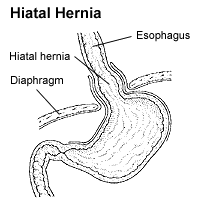
Photo from wikipedia
BACKGROUND Patients born with a congenital diaphragmatic hernia (CDH) have a high mortality and morbidity. After discharge, complications and long-term morbidity are still encountered. This study describes the factors related… Click to show full abstract
BACKGROUND Patients born with a congenital diaphragmatic hernia (CDH) have a high mortality and morbidity. After discharge, complications and long-term morbidity are still encountered. This study describes the factors related to the surgical long-term outcomes in CDH survivors. METHODS A cohort of CDH patients born between 2000 and 2014, with a minimum of two years follow up, were included in this retrospective study. Demographics, CDH specific characteristics, treatment, and long-term surgical outcome were evaluated using multivariate logistic regression analyses. RESULTS 112 patients were included, with a mean follow up of 7.3 years (SD 3.8). The majority had primary repair, but 31% received patch repair. Recurrence was reported in 7% of all patients. However, recurrence risk increased for patients with extracorporeal membrane oxygenation (ECMO) treatment (ORadjusted: 6.3, 95% CI: 1.2-33.9). This risk was highest for patients needing both ECMO and patch repair (OR: 11.2, 95% CI: 2.3-54.1). Small bowel obstructions (SBO) were observed in 20% and was associated with patch repair (ORadjusted: 3.5, 95% CI: 1.2-10.0), but ECMO treatment seemed to reduce this risk (ORadjusted: 0.2, 95% CI: 0.0-1.0). Thoracic deformations (36%) was diagnosed most often after patch repair, especially when ECMO was needed (60%) as well. CONCLUSIONS This retrospective study shows that the incidence of surgical long-term morbidity of CDH is relatively high, with different factors accounting for this. Diaphragmatic hernia recurrence was strongest associated with ECMO treatment in combination with patch repair, while SBO's were associated with patch repair, with an unexpected protective effect of ECMO treatment. TYPE OF STUDY Retrospective comparative study - Level III evidence.
Journal Title: Journal of pediatric surgery
Year Published: 2018
Link to full text (if available)
Share on Social Media: Sign Up to like & get
recommendations!